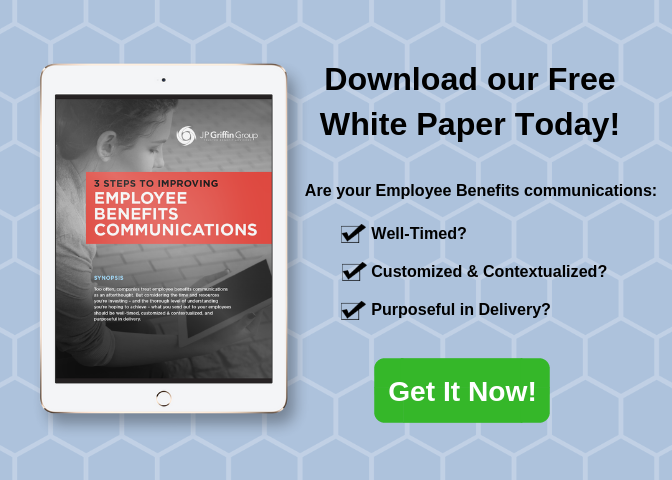 While dental and vision care are typically the second and third most popular employee benefits after health insurance, employers should look long and hard at short term disability and long term disability insurance as "must haves" in their benefits portfolio.
While dental and vision care are typically the second and third most popular employee benefits after health insurance, employers should look long and hard at short term disability and long term disability insurance as "must haves" in their benefits portfolio.
Why? Well, when someone in the organization misses a considerable amount of work due to an injury or illness, there isn't a business owner we've met who doesn't then struggle with the incredibly difficult decision of how best to resolve the issue.
Not only is the impacted employee struggling with a loss of income, but the employer is also struggling with compensation decisions regarding this individual during their absence, not to mention compensation investments that might have to be made to fill the position left open in this person's absence.
Everyone is spared these difficult decisions if disability insurance is in place. That's because disability insurance protects your employees from a disruption in income in the event of an injury or accident. (This should not be confused with Workman's Compensation. While they are similar, the main difference is that Workman's Compensation only covers employees for illnesses or injuries which are work-related.)
So let's examine the trends in long term and short term disability insurance and discuss tactics to improve employee participation.
Access to Disability Insurance Is Improving
Over the last 10 years, the Bureau of Labor Statics reported a slight increase in employer-provided access to both short and long-term disability insurance plans. For the private sector in 2008, employees having access to short-term disability insurance was 39 percent, vs. 42% in 2018. Similarly, in 2008, 23 percent of government employees had access to short-term disability insurance vs. 26 percent in 2018.
For long-term disability coverage, the increase within these groups were negligible, but an increase nevertheless. Here, for the private sector in 2008, the percent of employees with access to long-term disability insurance was 32 percent, compared to 34% in 2018.
Lack of Interest Frustrates Employers
One of employers’ biggest frustrations with offering short-term and long-term disability insurance is low enrollment. Many employers feel as though it’s a waste of time because only a handful of employees sign up for it.
If presented strictly as a voluntary benefit, it can be admittedly difficult to convince people they could benefit from enrolling. It's unfortunate, but most people think they won’t ever become disabled or be unable to work for any period of time, let alone a long period of time — and in theory, that’s true. The majority of people don’t experience such a thing. However, 20 percent of men and 28 percent of women under the age of 35 will become disabled for a period of time longer than 90 days at some point prior to retirement.
Nevertheless, it’s hard to convince people (especially the "young invincibles") that disability insurance is a worthwhile investment. As with most things in life, education is the key here. If you offer short or long-term disability insurance and your workforce doesn’t seem to be interested, it’s possible your employees just don’t understand how it could benefit them, nor how devastating life can become without income protection. They also might not realize just how typically inexpensive the benefit is for the enormous value it provides.
How To Improve Benefit Participation
Cover a Greater Percentage of Premium: Employers continue to shift the cost of employee benefits onto workers' shoulders, and disability insurance is unfortunately no exception (despite being remarkably inexpensive.) While the upside here is that the benefits will be tax-free if employees pay for the coverage themselves with after-tax dollars, the downside is that fewer employees will enroll in coverage to begin with.
Reducing employee premium expense will undoubtedly improve enrollment. If that's not possible through cost shifting, then consider covering 100% of a core basic benefit that replaces 40 percent or 50 percent of income, while offering workers the opportunity to "buy up" to more generous income replacement of 60 percent or 70 percent. The benefit will be cheaper for the employer to put in place and this will at least ensure that everyone has some level of income protection.
Auto-Enroll Your Workforce: As the book "Nudge" suggested through a tactic known as "choice architecture", employers who pre-select disability insurance for their employees during the enrollment process enjoy remarkably higher enrollment rates than those who do not. By simply pre-checking a box (which is equally as easy for the enrollees to deselect), employers ever-so-gently "seed" the idea of disability insurance as a "no brainer". In doing so, they leverage the human tendency of inaction to help overcome a status quo bias.
According to a Kaiser Health News article on disability insurance, "Employers that auto-enroll employees in voluntary long-term-disability plans may get 75 percent of employees to participate, compared with 30 percent for employers that leave it completely up to workers."
Cover 100% of Premium: Of course the best way to provide this safety net to is to simply auto-enroll everyone and cover the entire cost of premium. In fact, while the numbers are falling, approximately 85 percent of employers cover the full cost of short-term disability insurance, while 94 percent of employers cover the full cost of long-term disability insurance.
This is especially helpful if you are offering other voluntary coverage options such as critical illness, accident, hospital indemnity and cancer insurance. "These coverages all feel the same, and if you're going to choose one at all, you tend to go with the one that's cheapest and the one that you think you might use," says Carol Harnett, president of the Council for Disability Awareness, a membership group of disability insurers that does education and outreach about disability issues.
So How Does Disability Insurance Work?
 Both short and long-term disability insurance are meant to supplement a person’s income in the event they become ill or disabled and are unable to work. As the names suggest — short-term disability insurance is for shorter periods of time (typically a few months, but up to two years) and long-term disability insurance is for lengthier periods of time (more than two years, and sometimes decades).
Both short and long-term disability insurance are meant to supplement a person’s income in the event they become ill or disabled and are unable to work. As the names suggest — short-term disability insurance is for shorter periods of time (typically a few months, but up to two years) and long-term disability insurance is for lengthier periods of time (more than two years, and sometimes decades).
Anything could happen that would cause someone to use their short or long-term disability insurance policy: a car accident, major surgery, cancer, or stroke, just to name a few. In any of these cases, the employee could require an extended leave of absence from work. Eligible workers could file for FMLA, but employers aren’t required to pay employees for that time away from work, leaving them vulnerable at a time when they’re likely to be incurring additional (and probably excessive) medical bills.
Because of this, short-term disability is often used to supplement women’s income during maternity leave. How many weeks the insurance will pay for is dependent upon how complicated the delivery is (whether surgical or not, among other complications), but can be between six and eight weeks, at which point unpaid leave would begin.
Of course short-term disability insurance could be used for many other reasons, such as surgical recovery, injuries that limit a person’s ability to work, and sudden illness. If a person is unable to work for longer than short-term disability will allow — usually after three to six months, long-term disability kicks in, covering between 50 and 60 percent of the disabled worker’s salary. In some instances, this insurance would pay for years, and possibly until retirement.
While neither type of disability insurance covers a person’s entire salary, having even part of it covered is often helpful, especially for those who don’t have a lot of savings (like most Americans).
The "Benefit Tax Choice" Option
As discussed earlier, premiums for short term and long term disability insurance are sometimes paid by the employer, sometimes paid by the employee, and sometimes shared by both parties. Whenever this benefit is paid by the employer, it's typically paid pre-tax, which means the employee will have to pay taxes on the funds they receive while out of work, per IRS regulations.
To prevent this tax-hit at a what is almost always a financially vulnerable moment, some employers have adopted a work-around referred to as a “benefit tax choice option." This is an option given to an employee to pay the insurance premium themselves, with post-tax dollars (the employer typically handles the payroll deductions). In opting to go this route, the employee is then spared from having to pay taxes on disability funds they receive.
While it seems counter-intuitive for an employee to give up what would otherwise be an employer-funded benefit for one in which they pay for themselves, it's often times a cost an employee would gladly pay once they pencil out the two different scenarios.
Illustrating The "Benefit Tax Choice" Option: Let's assume an employee makes $40,000 a year, is taxed at 30% and is covered by a disability insurance policy which pays 60% of salary. Let's also assume that the premium costs 30 cents for every $100 of salary.
- Pre-Disability Income: $40,000
- Taxes On Income: $12,000 (Federal, State, FICA)
- Net Take Home Pay: $28,000 (70 percent net take-home pay)
Employer-Paid Disability Scenario:
- Disability Benefit: $24,000 per year (60% of pre-disability income)
- Taxes: $7,200
- Net Benefit if Taxed: $16,800 (70 percent of former take-home pay)
Employee-Paid Disability Scenario:
- Disability Benefit: $24,000 per year (60% of pre-disability income)
- Insurance Premium: $120 (40,000 x 0.25/100)
- Net Benefit if Not Taxed: $23,880 (85.3 percent of former take-home pay)
Now it should be noted that for employees in this example who don't go out on disability, they would wind-up paying $120 a year for disability insurance. Nevertheless, by taking home $7,080/year more in disability income, employees in the "employee-paid disability scenario" could afford to pay for disability insurance for 59 years before this scenario didn't make the most financial sense.
How Short and Long-Term Disability Insurance Can Increase the Value of Your Employee Benefits Package
For employers looking to strengthen their employee benefits package, short-term and long-term disability insurance are some of the very best products to consider. Both products benefit employers and employees alike.
Baby boomers and Gen Xers are interested in disability insurance because they want to protect their retirement savings. Being unable to work for months on end so close to retirement can have a very detrimental effect on 401(k)s and IRAs, as there is less time to make “catch up” contributions.
And while it may be difficult to sell Millennials and Gen Z on the value of disability insurance, it may actually benefit them more than those in other demographic groups. Because they are likely to be earning less income than their Gen X and Baby Boomer counterparts, they are also less likely to have money set aside for emergencies.
Education is Key
If offered as a voluntary benefit, education is the key to enrollment — not that you’ll get everyone to sign up, but the more people understand about short-term and long-term disability insurance, the more people are likely to hop on-board.
Be sure to include pertinent information about short-term and long-term disability insurance in your employee handbook, such as how these types of plans work, who pays for them, the tax implications, and how women hoping to start a family can use short-term disability during maternity leave (especially if you don’t offer paid leave). In addition, include statistics on the likelihood that a person will become disabled during their lifetime (you can use the source we linked to above).
The goal is not to scare people into enrolling, but to show them the benefits of doing so. If they don’t want disability insurance, that’s certainly fair, but those who would like to take advantage of this benefit should be properly educated on how it works.
Do you offer short-term and long-term disability insurance to your workforce? Leave us a comment below or contact us. We’d love to hear from you!

















